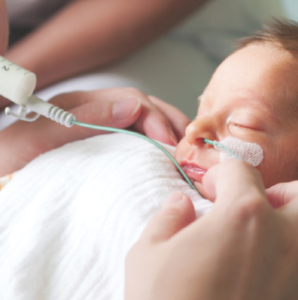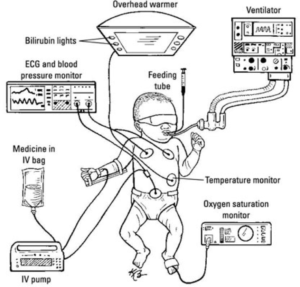Demystifying the
Neonatal Intensive Care Units (NICU)

Both the concept and the reality of having a baby in the Neonatal Intensive Care Unit (NICU) is both scary and unsettling. Such tiny babies. So much complex equipment. So many monitoring devices. So many unknowns.
How long will be baby be there?
What are all these contraptions?
What do they do?
In an attempt to settle some of your fears and answer some of your many questions we will review some of the common equipment and testing your baby may need.

What is some of the common monitoring equipment is used in the NICU?
Neonatal Intensive Care Units (NICUs) are equipped with complex machines and monitoring devices designed for the unique needs of tiny premature babies and full-sized one that need additional help breathing or regulating themselves. The following list includes some of the monitoring equipment often used in the NICU:
- Heart or cardiorespiratory monitor. The ECG monitor displays a baby’s heart rate and breathing rates and patterns on a screen. Wires from the monitor are attached to adhesive patches on the baby’s chest, abdomen, and leg.
- Blood pressure monitor. The blood pressure is also found on the ECG monitor. Your baby’s blood pressure is measured using a small cuff placed around the baby’s upper arm or leg. Some babies need continuous blood pressure monitoring and others are intermittent. Babies that require continuous monitoring will also have a catheter (small tube) in one of the baby’s arteries. Sometimes this is done using the baby’s umbilical cord.
- A temperature probe is placed on the baby’s skin with an adhesive patch. A wire connects the temperature probe to the ‘overhead warmer’ to help regulate the heat needed to keep the baby warm.
- A pulse oximeter (also called Pulse Ox). Measures the amount of oxygen in the baby’s blood through the skin. A tiny light is taped to the baby’s finger or toe, or in very tiny babies, a foot or hand. The light appears reddish and it connects to the monitor, displaying the amount of oxygen in the baby’s red blood cells.
- Endotracheal tube (also called ET). This tube is placed through the baby’s mouth or nose into the trachea or the baby’s throat. Held in place with special tape and connects to a mechanical ventilator or a breathing machine with flexible tubing. Therefore while the baby has an ET tube, he or she will be unable to make sounds or cry.
- Respirator or mechanical ventilator. This machine helps babies who cannot breathe on their own or helps babies to take bigger breaths deeper into the chest. Ventilators can also deliver extra oxygen to the baby if needed.
- Continuous positive airway pressure. Through small tubes that fit into the baby’s nostrils, called nasal CPAP, this machine pushes a continuous flow of air or medication to the airways to help keep baby’s tiny air passages open. CPAP can also be given through an ET tube if needed.
What is some of the additional testing common in the NICU?
- Ultrasound uses sound waves and a computer to create images of blood vessels, tissues, and organs. Ultrasounds can be used to view internal organs, verify organ function, and to assess blood flow. In the NICU, ultrasound may be used to examine the heart, abdomen, and internal structures of the baby’s brain.
- X-ray. X-ray machines may be brought to the baby’s bedside in the NICU. X-rays use invisible electromagnetic energy to produce images of internal tissues, bones, and organs on film. X-rays are taken for many reasons including checking the placement of catheters and tubes or to look at the baby’s lungs or bowels.
- Computed tomography (also called CT or CAT scan). A CT scan is a diagnostic imaging procedure that uses a combination of X-rays and computer technology to produce ‘sliced’ images of the body that cannot be seen otherwise or with other technology. The CT scan requires a special room and the baby may need a sedative medication so that he or she will be motionless for the exam.
- Magnetic resonance imaging (also called MRI). An MRI is a diagnostic procedure that uses a combination of a large magnet, radio frequencies, and a computer to produce detailed images of organs and structures within the body. Like a CT scan, MRI is performed in a room of the hospital. The baby will need a sedative medication so that he or she will be motionless for the exam.
NICU can be an unsettling location fraught with the unknown. However, if your baby needs this support, the care and skill of the team overseeing them are highly specialized. The treatment plan is oriented around getting your baby stable and healthy so that they can go home with you when they are ready.
There may be additional tests or assessments that your baby must pass before going home. Speak to your baby’s team about discharge requirements and expectations.
Stay strong family. Soon your baby will be home and in your arms.
Here are some additional resources for you:
Share Your Story an online community for parents like you.
Preemie Parent Alliance Support for parents of preemies
Preemie World Resources and newsletters for new parents.
